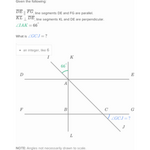| Finding angle measures 1 | |
|---|---|
 | |
| Description | |
| Exercise Name: | Finding angle measures 1 |
| Math Missions: | 8th grade (U.S.) Math Mission, High school geometry Math Mission |
| Types of Problems: | 3 |
The Finding angle measures 1 exercise appears under the 8th grade (U.S.) Math Mission and High school geometry Math Mission. This exercise uses several facts about the angles to practice finding missing angles in geometric diagrams.
Types of Problems[]
There are three types of problems in this exercise:
- Apply the triangle sum theorem: This problem provides a diagram with a triangle. The user is asked to use facts about the angles in triangles to find a missing angle.

Apply the triangle sum theorem
- Apply the transversal angle theorems: This problem provides a diagram with a pair of parallel lines and a transversal. The user is asked to use facts about the angles in triangles to find a missing angle.

Apply the transversal angle theorems
- Apply the basic angle theorems: This problem provides a diagram with a set of lines that intersect at a single point. The user is asked to use facts about the angles in triangles to find a missing angle.

Apply the basic angle theorems
Strategies[]
Knowledge and comfort with the angle theorems are instrumental to doing this exercise correctly.
- In triangles the sum of all angles in a triangle is and the measure of an exterior angle is equal to the sum of the two remote interior angles.
- With transversals and parallel lines, alternate interior angles, corresponding angles, and alternate interior angles are congruent. Additionally, same-side interior and exterior angles are supplementary.
- With intersecting lines vertical angles are congruent, perpendicular lines form right angles, and the sum of the angles in a line is .
Real-life Applications[]
- Geometric concepts, such as the ones used in this exercise, are instrumental in architecture (drafting), art and graphical design.
- Geometry is important for computer aided design.
- Engineers and architects use angles for designs, roads, buildings and sporting facilities.
- Athletes use angles to enhance their performance. Carpenters use angles to make chairs, tables and sofas.
- Artists use their knowledge of angles to sketch portraits and paintings.


